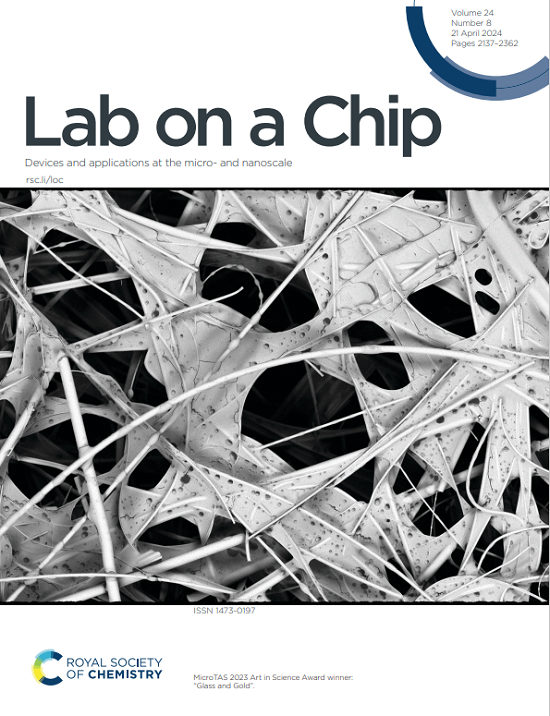Analysis of Sperm Beating Characteristics Using Microfluidic Trapping and Machine-Learning-Based Flagellum Tracking
IF 5.4
2区 工程技术
Q1 BIOCHEMICAL RESEARCH METHODS
引用次数: 0
Abstract
Male infertility affects a significant portion of couples worldwide, with standard semen analysis often failing to identify functional deficiencies in sperm performance. This study presents a microfluidic platform for characterizing sperm flagellar beating patterns with unprecedented detail, providing insights into sperm functional parameters potentially linked to unexplained infertility. We combined microcontact printing of fibronectin adhesion spots with machine-learning-based flagellum tracking to immobilize sperm heads while allowing free flagellar movement, enabling precise analysis of beating characteristics. Our tracking algorithm utilizes YOLOv8 (You Only Look Once) machine learning-based computer vision model and which we trained using 750 manually annotated images of sperm cells. We used keypoint detection along the sperm flagellum to calculate critical beating parameters including the beating amplitude, frequency, and asymmetry patterns. To validate the platform, we investigated the effects of established capacitation and hyperactivation agents on sperm motility. Caffeine treatment (10-40 mM) increased flagellar beat amplitude by up to 65% while decreasing frequency by approximately 50%, with pronounced asymmetrical beating consistent with hyperactivation. Heparin exposure (10-100 μg/ml) similarly enhanced beating amplitude by approximately 25% without significantly altering frequency. We also analysed the beating pattern of sperm cells immobilized inside a microchannel under different flow velocities. Results revealed a decrease in the beating frequency when sperm cells were subjected to flow. The platform eliminates the need for sophisticated sperm tracking techniques which facilitates high-throughput analysis under controlled physicochemical conditions. By enabling detailed characterization of sperm flagellar behaviour under various stimuli, our platform offers a valuable tool for investigating molecular mechanisms underlying idiopathic male infertility and evaluating potential therapeutic interventions.基于微流体捕获和机器学习的鞭毛跟踪的精子跳动特性分析
男性不育症影响着全球很大一部分夫妇,标准的精液分析往往无法识别精子性能的功能缺陷。本研究提出了一个微流控平台,以前所未有的细节表征精子鞭毛跳动模式,为精子功能参数提供了可能与不明原因不育相关的见解。我们将纤维连接蛋白粘附点的微接触打印与基于机器学习的鞭毛跟踪相结合,在允许鞭毛自由运动的同时固定精子头,从而精确分析跳动特征。我们的跟踪算法使用基于YOLOv8 (You Only Look Once)机器学习的计算机视觉模型,我们使用750张人工注释的精子细胞图像进行训练。我们利用沿精子鞭毛的关键点检测来计算关键的跳动参数,包括跳动幅度、频率和不对称模式。为了验证该平台,我们研究了已建立的获能和超激活剂对精子运动的影响。咖啡因处理(10-40 mM)使鞭毛跳动幅度增加了65%,而频率减少了约50%,明显的不对称跳动与过度激活一致。肝素暴露(10-100 μg/ml)同样增强搏动幅度约25%,但频率没有明显改变。我们还分析了固定在微通道内的精子细胞在不同流速下的跳动模式。结果显示,当精子细胞受到流动时,跳动频率降低。该平台消除了对复杂的精子跟踪技术的需求,该技术有助于在受控的物理化学条件下进行高通量分析。通过详细描述各种刺激下的精子鞭毛行为,我们的平台为研究特发性男性不育症的分子机制和评估潜在的治疗干预提供了有价值的工具。
本文章由计算机程序翻译,如有差异,请以英文原文为准。
求助全文
约1分钟内获得全文
求助全文
来源期刊

Lab on a Chip
工程技术-化学综合
CiteScore
11.10
自引率
8.20%
发文量
434
审稿时长
2.6 months
期刊介绍:
Lab on a Chip is the premiere journal that publishes cutting-edge research in the field of miniaturization. By their very nature, microfluidic/nanofluidic/miniaturized systems are at the intersection of disciplines, spanning fundamental research to high-end application, which is reflected by the broad readership of the journal. Lab on a Chip publishes two types of papers on original research: full-length research papers and communications. Papers should demonstrate innovations, which can come from technical advancements or applications addressing pressing needs in globally important areas. The journal also publishes Comments, Reviews, and Perspectives.
 求助内容:
求助内容: 应助结果提醒方式:
应助结果提醒方式:


